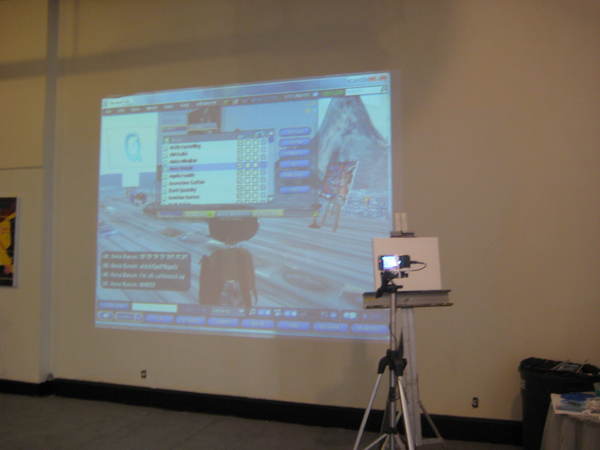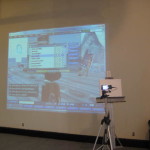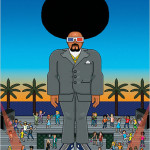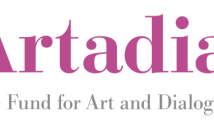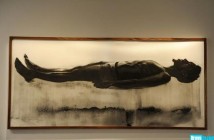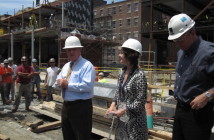By JAMES A. NADEAU
A week or so ago I had the opportunity to visit the studio of Jeffrey Lipsky. Lipsky is an artist who is exploring the opportunities of both art making and art dealing in the online virtual space of Second Life (SL). I was visiting his studio on the occasion of an “Art Fight Fundraiser.” The art fight was to take place in Second Life with Lipsky, using his SL alter ego Filthy Fluno, against Genevieve Silvercloud (whose non-SL name I didn’t learn). Lipsky was painting in his real life (RL) studio in Lowell and Genevieve was in her studio in Toronto. Meeting up in a predetermined space the two of them set out to create a piece of work in real time, which was then auctioned off. The set up went like this: Lipsky painted at an easel with a camera over his shoulder recording the action. Directly in front of him, projected on the wall was the real time session in Second Life. The event had music with a live DJ who resided somewhere (I have no idea where she/he was located) and people from all over Second Life could pop in with their avatar and watch and comment as the painting competition went on. There were some technical issues, (Genevieve’s video wasn’t populating in the virtual space so we really had no idea what she was painting). But overall it seemed to work smoothly and people from all over (the world I imagine as SL has thousands of members internationally) popped in and out to observe and comment. The event made me think about how we go about creating, not just art, but art communities. And just how does technology solve or create new issues about art and art making?
First things first, just what is Second Life you might be asking? Well, it is an online 3D virtual world where content is created and managed by its users. It is a dynamic, interactive space that while at times can be conceptually confusing (I’ll go into that later) really seems to be a useful tool for making connections. But for art making? I wasn’t initially convinced. A few years ago when SL initially emerged I was curious about it and spend some time with it. Unfortunately, as I am not a people person to begin with, it didn’t hold my interest. So I was skeptical upon arriving at Lipsky’s studio. One thing that I kept coming back to was the nature of the online virtual world itself. Second Life is an online space so I imagined interest fluctuated along with cultural tastes, much like most web content. We have become creatures who flit from site to site. With each visit to the net bringing different fascinations (or maybe that is just me?). I knew that as a virtual space it had evolved to the point of having its own currency and economic flow. Lipsky has created a virtual art gallery where his work hangs for sale. His is one of a number of artist created spaces around which an SL community has grown. But did the community of users still exist to the extent where one could create a space the compliments the real world? And what were the implications of that? And how were artists using it?
When watching Lipsky perform (or painting I should say – although I would argue that is a performative moment) in front of me in the studio I was also watching his avatar Filthy perform in the virtual space. However, Filthy wasn’t performing Lipsky’s actions. He was performing a dance, which has become a trademark of the character. For the SL viewers to watch Lipsky paint they had to be on his website where the live video was streaming. Sorry if this is confusing. As I write this I am realizing how convoluted this can seem. In some ways, that is the complication inherent in an event like this. Navigating the technologies involved, while intuitive to more and more people, actually does have a fairly high bar. One has to be able to master the technology to participate. It is as if there is a language particular to this community (the SL one) and it is based upon technical skills. But I digress.
What I found fascinating when watching Lipsky paint was just how much the digital interaction has actually affected his style. There was an example of an earlier work hanging in the studio next to more recent paintings. Both the form and the palate were very different. Where one was organic and had a flow (despite being a depiction of a machine), the newer work was much more geometric and had a color tone similar to that seen on a computer screen. It was interesting to see just how one feeds and changes the other. Lipsky admitted to posting images of his paintings in his gallery in SL and then having to go back and make changes to the original work so that they looked the same. In using SL to market and disperse his work, he has actually changed the way he paints. The paintings can’t help but be linked. If you offer an artwork online, the real thing better look like that. By linking the real with the virtual Lipsky’s work had to change.
Perhaps this is one of the drawbacks of virtual creation? You are tied to it in a symbiotic relationship. I recognize this every time I sit at my computer to edit a video or scan a photo. It is no longer just about the artwork. It is about how the technology is going to get me from A to Z. This is something that has always been inherent to video art. It is by its nature a technological art form. To watch this happen with the more traditional arts is actually pretty invigorating. There has always been a privileging of the traditional over the technological. I think it is great that the two have converged. It has happened with photography (although this really is a technology based art form as well) so why not painting? I imagine there are sculptors out there on Second Life as well. Although their biggest challenge must lay with the 3D modeling skill required to display their art.
Given the recent downturn in the economy and watching more and more galleries closing their spaces, what opportunities does this virtual world offer? There are certainly many places online to look at and purchase art. The Saatchi Gallery has a fairly dynamic and interactive online presence where one can post artwork but nothing quite like this. This is a community driven and created space. One can interact and speak directly with the artists. One can build relationships in a way that is a step beyond email-to-email. I keep returning to the term “dynamic” because that is how it feels to me. It is weird to call a technological interaction organic but that is very much how it feels. Despite the technological mediation there is something very familiar and mundane about the way one connects with SL. I see Lipsky interacting with people internationally yet in an immediate way. It is an amazing way of bringing your artwork to a larger audience. Second Life will never erase the day-to-day human interactions (at least for most of us) but I think it offers up another avenue for artists. It isn’t a perfect route of course; one should be prepared to have their work shift in ways you can’t foresee. But that element of transmutation can be exciting.
- Jeffrey Lipsky, Art Fight Live, Multi-Media, 2009.
- Jeffrey Lipsky, Filthy Fluno
All images are courtesy of the artist.

